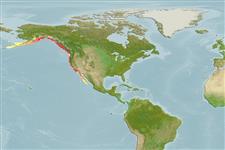Actinoptérygiens (poissons à nageoires rayonnées) >
Perciformes (Perch-likes) >
Zoarcidae (Eelpouts) > Lycodinae
Etymology: Lycodes: Greek, lykos = wolf + Greek, suffix, oides = similar to (Ref. 45335); pacificus: Named after the Pacific Ocean (Ref. 6885).
Environnement / Climat / Gamme
Écologie
; marin bathydémersal; profondeur 9 - 399 m (Ref. 2850). Deep-water, preferred ?
Eastern Pacific: Gulf of Alaska to northern Baja California, Mexico.
Length at first maturity / Taille / Poids / Âge
Maturity: Lm ?, range 14 - ? cm
Max length : 46.0 cm TL mâle / non sexé; (Ref. 2850); âge max. reporté: 5 années (Ref. 6885)
Description synthétique
Morphologie | Morphométrie
Épines dorsales (Total): 0; Rayons mous dorsaux (Total): 90-107; Épines anales 0; Rayons mous anaux: 70 - 90. Caudal sharply rounded but not readily distinguishable from dorsal and anal fins. Pelvic fins minute.
Found on silty or sandy bottoms (Ref. 27436). Moves into shallow water at night to feed on marine worms, crustaceans, small bivalves, and brittle stars (Ref. 6885, 27436). Few live over 5 years (Ref. 6885). If used live as bait, it attracts large rockfishes, greenlings or codfishes (Ref. 27436). Flesh considered good but not esteemed (Ref. 27436).
Life cycle and mating behavior
Maturité | Reproduction | Frai | Œufs | Fécondité | Larves
Anderson, M.E., 1994. Systematics and osteology of the Zoarcidae (Teleostei: Perciformes). Ichthyol. Bull. J.L.B. Smith Inst. Ichthyol. 60:120 p. (Ref. 11954)
Statut dans la liste rouge de l'IUCN (Ref. 115185)
CITES (Ref. 94142)
Not Evaluated
Menace pour l'homme
Harmless
Utilisations par l'homme
Pêcheries: pêcheries vivrières
Plus d'informations
Taille/ÂgeCroissanceLongueur-poidsLongueur-longueurFréquences de longueursMorphométrieMorphologieLarvesDynamique des populations larvairesRecrutementAbondance
RéférencesAquacultureProfil d'aquacultureSouchesGénétiqueFréquences alléliquesHéritabilitéPathologiesTraitementMass conversion
CollaborateursImagesStamps, CoinsSonsCiguateraVitesseType de nageSurface branchialeOtolithesCerveauxVision
Outils
Articles particuliers
Télécharger en XML
Sources Internet
